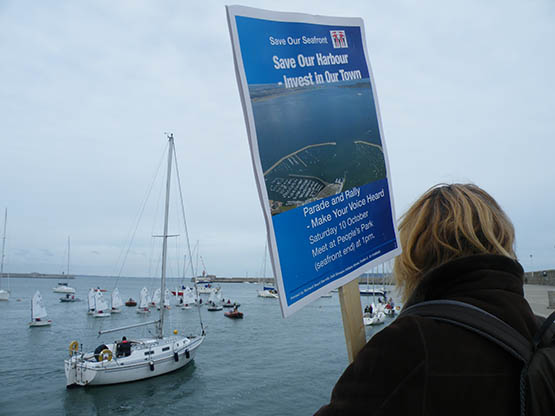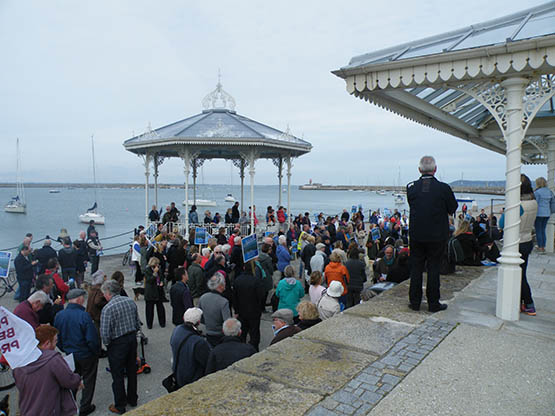Displaying items by tag: Cruise Liners
Dún Laoghaire Cruise Berth Cost-Benefit Analysis ‘Not Required’
#CruiseCostAnalysis - At the planning inquiry on Wednesday, heated exchanges arose into Dún Laoghaire Harbour Company’s proposed cruise ship berth, reports The Irish Times.
The harbour company is seeking planning permission for a 400m berth to accommodate some of the world’s largest cruise ships, with ancillary facilities, including the dredging of an approach channel inside and outside the harbour walls.
Answering questions on the €18 million investment associated with the project, Annette Hughes of DKM Economic Consultants, on behalf of the harbour company, said a cost-benefit analysis of the project had not been carried out as one “was not required”.
She said the fact DKM had carried out a cost-benefit assessment on a redevelopment project at Galway docks was “entirely irrelevant”, and objected to a line of questioning on the matter from Dr Pat McCloughan, who represented Dún Laoghaire Harbour combined sailing and yacht clubs.
Further coverage by the newspaper of the inquiry can be read by clicking here.
#CruiseBerth - Would a next-generation cruise berth in Dun Laoghaire actually do more harm than good?
That's the position of former Dun Laoghaire Motor Yacht Club vice commodore Dermot Reidy as the oral hearings on the controversial cruise berth proposal come to a close.
Writing in The Irish Times yesterday (Thursday 21 October), Reidy describes the Dun Laoghaire Harbour Company's ambitious cruise liner terminal plans as a "white elephant" and equates it with the retail over-expansion that has all but killed off the town's beleaguered Main Street.
"Dún Laoghaire needs cruise ships, certainly. But it needs ones that will dock in the harbour and contribute to the town and its economy," he writes. "It does not need 'Cities of the Seas' or five-star, floating Bulgarian apartment block-style vessels, each on the order of 17 storeys high and weighing 150,000 tons."
That's a notion supported by engineer Liam Shanahan, who told An Bord Pleanála's hearing on Wednesday (21 October) that the term 'cruise ship' in the context of the harbour company's planning application is a misnomer when such vessels are typically more than 11 storeys high and are comparable to "a mountain on a hull, with a power plant inside" – generating mass amount of air pollution when berthed.
Reidy, who supports an alternative future for Dun Laoghaire as a centre of sporting excellence, goes a step further by comparing the town's harbour to Phoenix Park as an amenity for both public and private use, and suggesting that the harbour's management be reorganised "into the existing structures that are available and willing to run them: the people via their elected councillors."
The oral hearings on the Dun Laoghaire cruise berth plans conclude today (Friday 23 October), with a final decision due by 8 January 2016.
Dun Laoghaire Cruise Berth Is 'Financial Gamble' Says TD
#CruiseBerth - An "unquantifiable financial gamble" is how local TD Richard Boyd Barrett described the proposed Dun Laoghaire cruise liner terminal at the first day of oral hearings into the plans.
According to The Irish Times, Barrett told the An Bord Pleanála hearing this past Wednesday (14 October) that no berth or harbour dredging project “in the world” at the scale of the Dun Laoghaire Harbour Company's plans that could be completed for €18 million – and claimed the scheme is "inextricably linked" with private development proposals for the harbour area.
Barrett voiced similar concerns at the 'people's protest' and boat rally held in the harbour last Saturday (10 October), in the same week that proposals for an alternative vision for the harbour as a national centre for watersports went online.
The Irish Times has more on the story HERE.
Proposal For National Watersports Centre In Dun Laoghaire Now Online
#DunLaoghaire - Proposals for a National Watersports Centre for Dun Laoghaire at the former HSS terminal are now online.
As previously reported on Afloat.ie, the idea was recently proposed by the Dun Laoghaire Combined Clubs (DLCC) to Dun Laoghaire-Rathdown County Council as they made their submission to the oral hearings on plans for a next-generation terminal for cruise liners in the harbour.
Those plans have attracted significant opposition in the locality, as evidenced by the large turnout for the joint boat rally and protest march against the scheme last weekend.
Rather than 'dividing' the harbour, as many opponents fear the cruise terminal would do, the DLCC say development of the HSS terminal as a 'National Watersports Academy' would help protect Dun Laoghaire's waterfront "as an outstanding recreational harbour and sporting amenity of national significance".
Based on the example of similar facilities in Pwllheli, Weymouth and Medemblik, the proposal envisages that Dun Laoghaire could host between 20 and 30 major events at such a centre throughout the year, "generating substantial additional revenue" for the town.
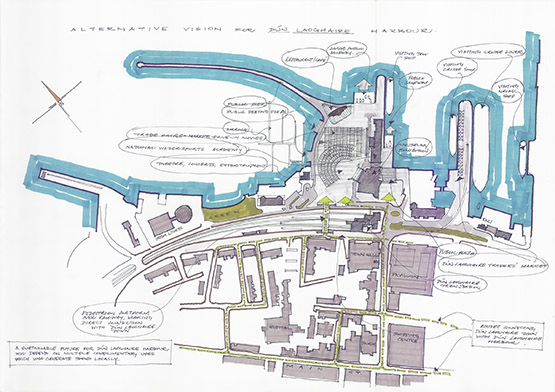
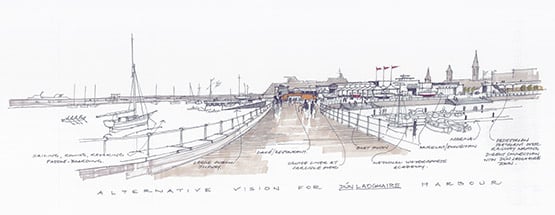
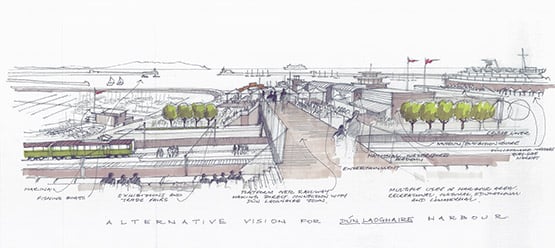
The complete proposal is available as a PDF to read or download HERE.
In 2010, The Irish Marine Federation (IMF) published a case study on the socio-economic significance of the 2009 Volvo Dun Laoghaire Regatta. The biennial event attracted an entry of 449 entries and is the biggest regatta in Ireland. Over four days, the study (carried out by Irish Sea Marine Leisure Knowledge Network) found the event was worth nearly three million to the local economy.
‘No Passport Required’ As Fred.Olsen Cruises Round UK and to Irish Ports
#NoPassportCruise - Boudicca, one of Fred. Olsen Lines quartet of cruiseships is currently on a ‘No Passport Required’ circumnavigation of the UK having departed Newcastle almost a week ago, writes Jehan Ashmore.
The aim of the ‘Myths & Legends of Ireland & UK’ cruise for up to 880 passengers who had embarked in Newcastle is to experience unravelling a host of intriguing myths, mysteries and legends around these beautiful coastlines.
Tonight Boudicca is making a northerly passage off Scotland through the Hebridean Isles.
Since her departure from Newcastle, a long-term Fred Olsen homeport, the 28,551 tonnes cruiseship made Portsmouth a first port of call and then headed for Falmouth.
Following her Cornish call to the West Country, Boudicca visited Cork (Cobh) which had another successful season as previously reported and where the 1973 built ship was the final caller.
Also visited where other large ports, Dublin and Belfast.
The remaining ports of the cruise will all be Scottish based with the next been Kirkwall, the capital of the Orkney Islands. From there it’s on to Invergordon and the mainland capital of Edinburgh (Leith).
Cruise-goers will then have a final leg in the North Sea with a return call to Newcastle, marking the completion of the round-cruise. The Tyneside port has long connections with Fred. Olsen, through ferry origins and with very strong ties with Norway.
Since 1987 the cruise operator has concentrated serving from UK ports. Asides Newcastle, the passenger embarkation ports are Avonmouth, Belfast, Dover, Greenock, Harwich, Liverpool, Rosyth, Southampton and Tilbury downriver of London.
One of many popular ports visited by Fred. Olsen is the Norwegian port of Bergen which was host to an historic occasion on 28 July as all the company’s fleet had docked for the first ever time and in the same port.
A once in a lifetime spectacle for almost 4,000 passengers disembarked from the cruiseships at the south-western port in what was hailed as ‘The Fred. Olsen Fleet Unites’.
The gathering was also dubbed the ‘4 B’s In Bergen’ event given that all Olsen cruiseship names begin with the letter B. So the Boudicca’s fleetmates are named Black Watch (a sister), Braemar and the flagship, Balmoral.
Bergen was chosen for the cruise lines quartet as the origins of the company can be probably traced back to the original Olsen brothers, Frederik, Christian and Peter.
According to Ships Monthly, (November issue), the brothers from Hvitsten near Oslo, brought their first ships in 1848.
The company in the following century shared a successful partnership with the passenger ferry operator, Bergen Line during the 1960’s and 1970’s.
Boat Rally Joins Peoples Protest Over Proposed Cruise-Berth for Dun Laoghaire Harbour
#CruiseBerthProtests - A boat rally campaign against the proposed €18m cruise-berth for Dun Laoghaire Harbour saw some 25 yachts yesterday gather at short notice, writes Jehan Ashmore.
The flotilla formed a line tracing the position of where the proposed 390m long jetty would sit inside the harbour, almost occupying the centre of the south Dublin Bay port. The cruise-berth would be able to accomodate some of the largest cruiseships in the world.
The boat rally was held in advance of the first official oral hearings to be held by An Bord Pleanala next week. The hearing will examine submissions lodged to An Bord Pleanala on the controversial issue of an application by Dun Laoghaire Harbour Company (DLHC) for planning permission to construct the facility. In total 150 submissions were lodged following a public consultation process when the harbour company unveiled its cruise-berth plans during Easter.
Critics of the cruise liner project say the new pier structure would split the harbour in two, bringing an end to sailing across the broad expanse of the artificial built harbour which has been a tradition for many generations.
Also yesterday was held the People's Rally, where local T.D., Richard Boyd Barrett cited despite the fact that another public-owned harbour, Dubin Port with its own cruise-berth terminal would be competing in effect and that Dun Laoghaire would lose out.
Also it was claimed that the proposed cruise-berth would be a prelude to preparing the harbour for 'privatisation'.
Protestors claim from fears over the impacts of dredging and damage caused during construction and continued maintenance costs. Also how such a facility would pose on the unique heritage values of the harbour and public amenities was also raised.
The DLHC is to be transferred to Dun Laoghaire-Rathdown County Council, however the direction of the how the local authority would manage the port was also questioned against the backdrop of the Harbours (Amendment) Bill due before the Dail.
On completion of the rally held in the centre of the harbour, the yachts were joined by dinghy craft to form a larger flotilla in support of the People’s Rally held at the East Pier bandstand.
The first day of the oral hearing is to begin next Wednesday, 14 October.
Boat Rally Against Dun Laoghaire Cruise Berth Tomorrow
#CruiseBerth - Royal St George Yacht Club members will host a boat rally in Dun Laoghaire Harbour tomorrow Saturday 10 October at 1pm in support of the People's Rally against cruise liner berth proposals taking place at the same time at the People's Park.
Club members are called to meet with their boas at the harbour mouth for one hour, with the intention of massing a flotilla of boats in the shape and size of the proposed 435-metre cruise pier, which critics say could split the south Dublin harbour in two and bring to an end generations of harbour sailing.
The fleet will be chaperoned, choreographed and photographed on the day by Royal St George club members who will assist in club ribs on VHF channel 72.
The protest takes place just days before the first official oral hearing into the cruise berth plans, which have already faced more than 150 objections.
#CruiseBerth - Objections to the Dun Laoghaire Harbour Company's ambitious cruise liner terminal proposals face number more than 150 ahead of oral hearings into the plan, as The Irish Times reports.
And one submission, from the Water Wags Sailing Club, even draws on marine engineering experience to argue that the scheme as it stands poses "real and significant risks to the stability of the harbour piers".
The club's position was among a host of submissions to An Bord Pleanála along with those of local sailors, the harbour's long-standing yacht clubs and their representative body the Dun Laoghaire Combined Clubs (DLCC), which organised a briefing session earlier this week to advise members on making their own voices heard.
Complaints have highlighted environmental concerns around the dumping of silt from channel dredging necessary to accommodate larger cruise ships, and the impact a next-generation cruise liner terminal would have on recreational and sports boating in the South Dublin harbour, with campaigners previously calling for an 'alternative vision' for Dun Laoghaire that makes a virtue of its existing benefits.
Indeed, along with its own submission, the DLCC has made a proposal to Dun Laoghaire-Rathdown County Council that the harbour be protected "as an outstanding recreational harbour and sporting amenity of national significance", and that the former Stena HSS terminal be repurposed as a 'National Watersports Academy' along the lines of the recently opened world-class facility at Pwllheli in North Wales.
The DLCC's presentation to DLRCoCo can be downloaded below.
Briefing Session Ahead Of Oral Hearing On Dun Laoghaire Cruise Berth
#CruiseBerth - The Dun Laoghaire Combined Clubs (DLCC) will host a briefing session tomorrow evening (Wednesday 30 September) ahead of next month's oral hearing on the Dun Laoghaire cruise liner berth plans.
The briefing, which starts at 7pm at the National Yacht Club, will advise club members on how to participate in An Bord Pleanála's oral hearing process, which begins with a preliminary meeting on Wednesday 7 October before the hearing proper commences on Wednesday 14 October.
The briefing will be conducted by Ann Mulcrone of Reid Associates, Planning Consultants, who has acted as chief co-ordinator for the submission prepared by the DLCC over the Dun Laoghaire Harbour Company's proposals for a next-generation cruise liner berth in the harbour.
Oral Hearings to be Given Into Dun Laoghaire Harbour’s Proposed Cruise-Berth
#CruiseBerthHearings - At almost 100,000 tonnes Mein Schiff 4, the largest ever cruiseship to anchor so close to Dun Laoghaire Harbour yesterday, was also the same day that Afloat.ie learnt that An Bord Pleanála is to proceed with oral hearings into the planning application of the proposed yet controversial €18m cruise-berth, writes Jehan Ashmore.
An Bord Pleanála has advised that both of the oral hearings are to be begin next month. The hearings in October are been held in accordance with section 134 (I) of the Planning & Development Act 2000, in respect of the Dun Laoghaire Harbour Company’ s planning application for the cruise-berth facility.
The proposed 435m long single cruise-berth jetty, associated structures and dredging of the channel off St. Michaels Wharf and a 500m turning circle outside the harbour entrance would enable ships considerably larger than Mein Schiff 4 to dock in the harbour. The new $625m German cruiseship had anchored less than one nautial mile off the East Pier during her her maiden call to the harbour following a visit to Belfast Harbour.
Last month a deadline expired for a public consultation process on the cruise-berth project in Dun Laoghaire Harbour that led to An Bord Pleanála receiving 150 submissions.
Due to the scale and complexity of the planning application, the board of An Bord Pleanála, has decided to hold a preliminary meeting on 7 October in advance of the more substantive oral hearing to be held a week later on 14 October. This second hearing is scheduled to run for approximately 8 days over two separate timeframes within that month.
A Senior Planning Inspector has been appointed by the board of An Bord Pleanála during the oral hearings regards the submissions and observations raised in regards to the likely effects on the environment of the proposed cruise-berth. In addition, the consequences for proper planning and sustainable development in the area are to be considered, and the likely effects on a European site will also be reported to the board.
This latest development on the oral hearings reported here on Afloat.ie follows a Dun Laoghaire-Rathdown County Council meeting held earlier this week where, according to the Gazette, a request was made by local councillors for the An Bord Pleanála to conduct such hearings into the cruise berth project. A motion tabled by Cllr Victor Boylan (Ind) was held where 23 councillors were in favour of the oral hearing and 13 councillors voted against it.
Cllr Boyhan said he was “disappointed at the planning authority report drawn up by the council executive” and was therefore happy with the motion being passed to seek an oral hearing with An Bord Pleanála's planning inspector prior to a decision being made on the cruise berth.
He added: “I think it is significant that 150 people came together, and paid €50 per submission, to air their views on the proposed cruise berth plans.”
For more on the topic, click the local newspaper’s report here.



























